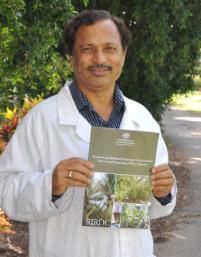Aussie native plants 'ready for use' as biodiesel feed stock
Published on 28 April, 2011
Up to 10 native plant species can be readily used as biodiesel feed stocks, growing in monoculture or mixed cropping systems, and could also help farmers reverse land degradation problems...
That's according to Associate Professor Nanjappa Ashwath from CQUniversity, who notes that promoting the use of native plants and establishment of centralised and co-operatively run processing plants could serve the interests of the rural community, as well as the Government's target of boosting Green Energy production to abate climate change.

Associate Professor Nanjappa Ashwath with a copy of his new publication
"In addition, some of the potential biodiesel plants are trees which could be harvested for timber at the end of their production," he said.
Dr Ashwath has published his latest findings in a Rural Industries Research and Development Corporation publication entitled Evaluating Biodiesel Potential of Australian Native and Naturalised Plant Species. This book can be downloaded ( https://rirdc.infoservices.com.au/items/10-216 ) or a hard copy can be purchased from RIRDC for $35.
This new report is targeted at those involved in decision making on alternative fuels and global warming, landcare groups and mining companies.
Dr Ashwath says more than 200 species and varieties have been evaluated for oil content, including the fruits, seeds and kernels of a large number of trees, shrubs, palms and ground cover species. Up to 20 species contained appreciable quantities of oil and up to 10 can be readily used as biodiesel feed stocks.
Interestingly, some species are naturalised and grow well in Queensland and other parts of the tropics, thus requiring minimum care for their cultivation. However, harvesting and processing techniques have to be customised to make the entire process cost effective.
Associate Professor Ashwath says the publication came out of a team project including tasks such as seed collection, oil extraction, conversion of the oil to biodiesel and testing the biodiesel for various properties.
"I thank the team which helped me complete these tasks, particularly the contributions of Pramod, Roshan, Subhash, Vineela, Amanda and Phul."
Further research is needed to determine specific details about the species, such as their agronomy, yield potential, harvesting procedures and mechanisation of oil extraction and biodiesel conversion. Funding and industry collaboration are being sought to undertake these studies.
Biodiesel from the Beauty Leaf tree, in particular, was subjected to complete fuel quality analysis, and also tested for engine performance. Detailed findings on this species are being written up as a PhD thesis by Subhash Hathurusingha.
"Since the Beaty Leaf Tree has great potential to be grown in central and northern Queensland, economic viability of establishing this species needs to be established. It is estimated that this species can yield up to 3800 litres of biodiesel per hectare per year after 5-8 years of establishment."
Dr Ashwath says the beauty of the ‘Beauty Leaf Tree' is that it can thrive on salty, drought-affected, acidic or waterlogged lands, which would otherwise remain unused.
He said a four-stage automated bioreactor had been constructed to convert the plant oil to biodiesel, and the resulting quality was found to be better than fossil fuel in terms of low carbon emissions.
Engine performance results also proved that the ‘Beauty Leaf Tree' biodiesel generated as much power as the fossil fuel.

